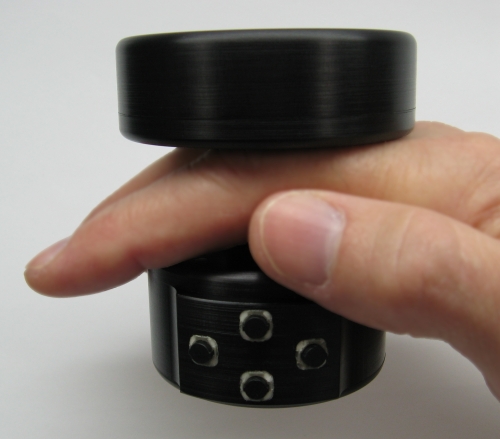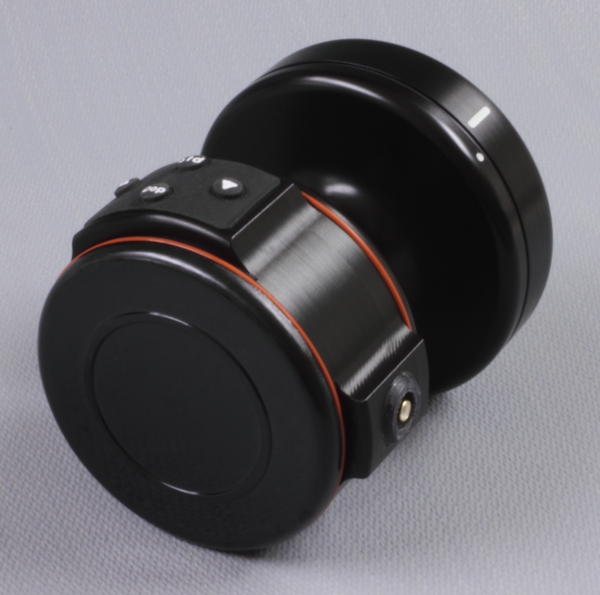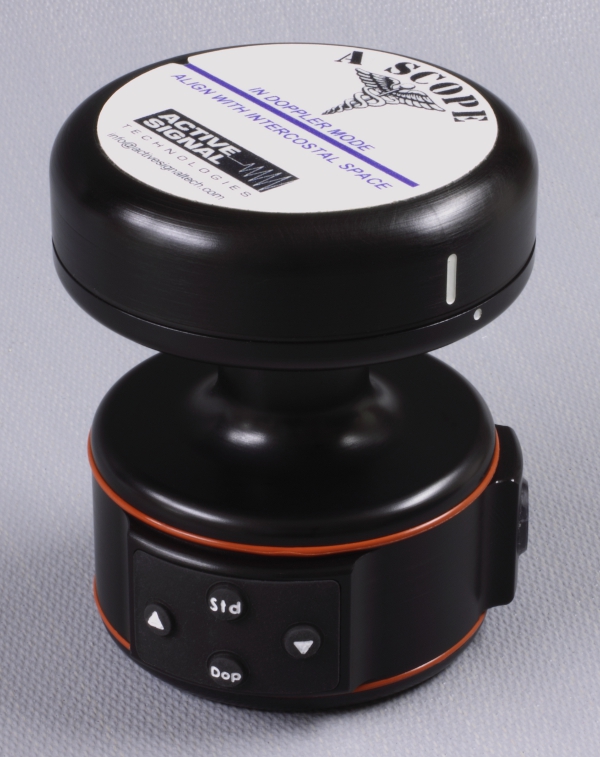Noise Immune Stethoscope (A SCOPE®)
In combat casualty and civilian emergency medical environments, an unmet need existed for a stethoscope that would enable the user to hear heart and especially breathing sounds in the presence of high ambient noise. The noise can be from helicopter and fixed wing aircraft as well as ambulances where the prevailing sound levels preclude auscultation with standard stethoscopes. Without this capability, patients can potentially expire from undetected collapsed lungs or loss of intubation integrity.
In cooperation with the U.S. Army’s Aeromedical Research Laboratory (USAARL) in Ft. Rucker, AL, Active Signal Technologies developed a noise immune stethoscope1 that has been tested in simulated Blackhawk helicopter environments up to 110 dBA, the limit of USAARL’s acoustic reverberation chamber. The device uses a combination of highly sophisticated sensors, signal conditioning and Doppler technology to accomplish this goal. It has been judged by the USAARL staff to be the only device in existence that enables the caregiver to hear heart and lung sounds in these environments.

Early prototype dual-mode noise immune stethoscope
This device has two operational modes. The passive or acoustic mode uses a direct contact acoustic pickup that is matched to the acoustic impedance of the body. This allows the stethoscope to accurately reproduce sounds generated within the body and offers a high level of rejection of external air borne sounds. However when the external sound level exceeds about 95 dBA the body begins to conduct the air borne sounds and they begin to overwhelm the internal body sounds. By switching to the Doppler mode, which operates at about 2MHz, the stethoscope moves beyond the range of any interfering sounds and is able to resolve the sound producing elements within the body, such the heart and the lungs by detecting their motion. The transducers for the two modes of the stethoscope are coaxially located which allows switching seamlessly from one mode to the other without having to relocate the stethoscope.
This Stethoscope has been tested in several environments, military and civilian. Its first tests were at Ft. Rucker’s USAARL’s reverberation chamber2 followed by successful airworthiness testing at the same facility. This device was featured in a presentation to the Aerospace Medical Association (AsMA) annual meeting in Orlando Florida in May 20064. Further military field testing has been conducted by a special ops unit stationed at Ft. Campbell, Ky. with follow-up testing by a Army Rangers unit. In November 2009, USAARL conducted a preliminary qualitative assessment of the production model of the noise immune stethoscope (NIS) at their Ft. Rucker test facility and published the results3.
Civilian testing has been conducted on various medevac units, and a formal study has been done in England using a passive only version of the stethoscope by members of the Southeast Coast EMS Service in their upgraded medevac fleet. This testing was conducted by 6 individual medics traveling in McDonnell Douglas MD 902 Explorers at a speed in excess of 150mph and at an altitude of approximately 800ft. The medics were able to hear heart and breathing sounds as well as bowel sounds during the flight.
In all cases, except for the highest background noise environments, the passive option allows perfectly adequate auscultation with the active Doppler feature available for higher noise environments.
The device is shown below in its pre-production configuration as modified in response to several rounds of Army user testing.

Pre-production version of dual-mode noise immune stethoscope
In addition to its external noise rejecting capability, the stethoscope provides greater sensitivity and fidelity than existing air-coupled bell and diaphragm stethoscope heads through its solid state direct contact sensor. The device detects and amplifies sounds over a much greater bandwidth than a conventional mechanical stethoscope, the response of which typically rolls off sharply above 1kHz. However, for the purpose of producing sounds comparable to those delivered by a conventional stethoscope, later versions incorporate a 500Hz low pass filter to reduce the amplitude of signals outside the normal frequency band used for auscultation.
The production version is now complete and shown in the photographs below. This version incorporates several enhancements to both performance and maintainability. The stethoscope has been ruggedized and the environmental seals have been enhanced. This device has passed a comprehensive series of MIL-STD 810F environmental tests and is FDA approved (510(k) Number K103499).



Production version
Maryland Precision Spring was very helpful with the design, engineering and production of critical internal components.
Data acquisition variant prototype noise immune stethoscope
The Air Force has funded modification of the stethoscope for incorporation into the monitoring suite used by the Critical Care Air Transport Teams (CCATT). This version, illustrated in the figures above and below, will provide a graphical output that can be displayed visually on the monitors employed by the CCATTs.
Noise immune stethoscope with USB data acquisition system
The dual-mode stethoscope may have applications beyond simple auscultation in loud environments. For example, observations at the University of Maryland Shock Trauma Center have revealed high pitched sounds associated with pneumothorax that are inaudible with a conventional stethoscope and have never before been reported in the literature. Similarly, in environments remote from the hospital setting cardiovascular findings may be enabled that would otherwise only be possible in the ultrasound lab. For example it may be possible to interrogate the condition of artificial heart valves and characterize bruits accompanying stenosis in major arteries. The Army is also initiating internal studies to evaluate the potential diagnostic capability of the Doppler mode for characterizing respiratory disfunction.
Future embodiments of the device may incorporate a display, record, and capture system for data viewing and archiving for later comparison or more precise diagnosis using algorithms that Active Signal has developed for brain injury diagnostics.
Noise immune stethoscope with complete USB data acquisition system including BAM sensors
References:
1 US Patent Application Publication No. US 2007/0165872.
2 A Dual-Mode Noise-Immune Stethoscope For Use In Noisy Vehicles, Houtsma, et. al, 4th ASA/ASJ Joint Meeting, Honolulu, HI, Dec. 2006.
3 Preliminary Characterization of the Noise-Immune Stethoscope (NIS) in High Ambient Noise Environment Using a Reverberation Sound Chamber, Gaydos SJ, Williams RA, Reeves ER, Kelley AM, Ft. Rucker, February 2010.
4 Dual-mode Auscultation in High High-Noise Level Environments, Houtsma AJ, Curry IP, Sewell JM, Bernard WN, AsMA, May 14-18, 2006
5 Development and Assessment of a Dual-Mode, Noise-Immune Stethoscope for Combat Environments, Brady SM, Gaydos SJ, Berry KA, NATO Research and Technology Organization, Essen (Germany) April 2010
